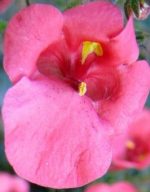 This clump-forming, stoloniferous, evergreen perennial is native to South Africa where it grows in mountainous areas along streamsides, on cliffs, and in rock crevices and gravely areas. It is a member of the figwort family, Scrophylariaceae, that also includes mullein, butterfly bush, and nemesia. Plants grow 12-18″ tall and have numerous soft blue-green wiry stems that sometimes become woody at the base and tend to be low growing with ascending tips. The blue-green narrow leaves are ovate, 1-3″ long and mostly clustered at the bottom of the stems. From spring to frost bright rose-pink flowers appear in terminal racemes that open from bottom to top. Each flower is 3/4″ across and has four small curly petals above a larger drooping lip, and two spurs containing oil that attracts bees. At the center of the flowers are dark yellow and maroon markings. D. integerrima is considered the most widespread, toughest, and floriferous of all the Diascia species. Although at least one form of D. integerrima, ‘Coral Canyon’, is hardy to USDA Zone 5, plants produce the best flower display if grown as annuals. It is a good choice for borders, rock and cottage gardens, and containers especially baskets where its trailing nature can best be appreciated. The genus name, Diascia, comes from the Greek di meaning two and askos meaning pouch, referring to the two sacs of the type species. The specific epithet, integerrima, is the superlative form of the Latin adjective integer, and means very entire, referring to the leaf margins.
This clump-forming, stoloniferous, evergreen perennial is native to South Africa where it grows in mountainous areas along streamsides, on cliffs, and in rock crevices and gravely areas. It is a member of the figwort family, Scrophylariaceae, that also includes mullein, butterfly bush, and nemesia. Plants grow 12-18″ tall and have numerous soft blue-green wiry stems that sometimes become woody at the base and tend to be low growing with ascending tips. The blue-green narrow leaves are ovate, 1-3″ long and mostly clustered at the bottom of the stems. From spring to frost bright rose-pink flowers appear in terminal racemes that open from bottom to top. Each flower is 3/4″ across and has four small curly petals above a larger drooping lip, and two spurs containing oil that attracts bees. At the center of the flowers are dark yellow and maroon markings. D. integerrima is considered the most widespread, toughest, and floriferous of all the Diascia species. Although at least one form of D. integerrima, ‘Coral Canyon’, is hardy to USDA Zone 5, plants produce the best flower display if grown as annuals. It is a good choice for borders, rock and cottage gardens, and containers especially baskets where its trailing nature can best be appreciated. The genus name, Diascia, comes from the Greek di meaning two and askos meaning pouch, referring to the two sacs of the type species. The specific epithet, integerrima, is the superlative form of the Latin adjective integer, and means very entire, referring to the leaf margins.
Type: Perennial
Bloom: Terminal racemes of rose-pink flowers with 4 curly petals above a larger lower lip and 2 spurs, from spring until frost
Size: 12-18″ H x 18-24″ W
Light: Full sun to partial shade
Soil: Fertile, moserately moist, well-drained; somewhat drought tolerant when established
Hardiness: Zones 5-10; does not do well in heat and humidity
Care: Deadhead to prolong flowering, cut back if flowering ceases to encourage rebloom
Pests and Diseases: Slugs and snails can be a problem
Propagation: Stem cuttings, seed
Companion Plants: African bluebell (Wahlenbergia undulatat), wild violet (Monopsis unidentata, wild squill (Scilla natalensis)
Outstanding Selections: ‘Coral Canyon’ (very hardy)